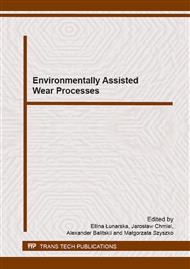[1]
M. Andersson et al., Clinical result with titanium crowns fabricated with machine duplication and spark erosion, Acta Odontol Scand 47 (1989) 279-286.
DOI: 10.3109/00016358909007713
Google Scholar
[2]
Z. Cai et al., Porcelain adherence to dental cast CP titanium: effects of surface modifications, Biomaterials 22 (2001) 979-986.
DOI: 10.1016/s0142-9612(00)00263-5
Google Scholar
[3]
Z. Cai et al., In vitro corrosion resistance of titanium made using different fabrications methods, Biomaterials 20 (1998) 183-190.
Google Scholar
[4]
K. Akagi, Y. Okamoto, T. Matsuura, T. Horibe, Properties of test metal ceramic titanium alloys, J Prosthet Dent 68 (1992) 462-467.
DOI: 10.1016/0022-3913(92)90411-3
Google Scholar
[5]
R. Schneider, M. de Goes, G. Henriques, D Chan, Tensile bond strength of dual curing resin-based cements to commercially pure titanium, Dent Mater 23 (2007) 81-87.
DOI: 10.1016/j.dental.2005.12.006
Google Scholar
[6]
S. Reich, A. Petschelt, U. Lohbauer, The effect of finish line preparation and layer thickness on the failure load and fractography of ZrO2 copings, J of Prosth Dent 99 (5) (2008) 369-376.
DOI: 10.1016/s0022-3913(08)60085-2
Google Scholar
[7]
J. Tinschert, D. Zwez, R. Marx, K. Anusavice, Structural reliability of alumina-, feldspar-, leucite-, mica- and zirconia-based ceramics, J Dent 28 (2001) 529-535.
DOI: 10.1016/s0300-5712(00)00030-0
Google Scholar
[8]
M. Ozcan, S. Kerkdijk, L. Valandro, Comparison of resin cement adhesion to Y-TZP ceramic following manufactures' instructions of the cements only, Clin Oral Invest (2007).
DOI: 10.1007/s00784-007-0151-y
Google Scholar
[9]
D. Qeblawi, C. Munoz, J. Brewer, E. Monaco, The effect of zirconia surface treatment on flexuar strength and shear bond strength to a resin cement, J Prosthet Dent 103 (4) (2010) 210-220.
DOI: 10.1016/s0022-3913(10)60033-9
Google Scholar
[10]
M. Blatz, J. Phark, F. Ozer, F. Mante, N. Saleh, M. Bergler, A. Sadan, In vitro comparative bond strength of contemporary self-adhesive resin cements to zirconium oxide ceramic with and without air-particle abrasion, Clin Oral Invest 14 (2) (2010).
DOI: 10.1007/s00784-009-0278-0
Google Scholar
[11]
R. Oyague, F. Monticelli, M. Toledano, E. Osorio, M. Ferrari, R. Osorio, Effect of water aging on microtensile bond strength of dual-cured resin cements to pre-treated sintered zirconium-oxide ceramics, Dent Mater 25 (2009) 392-399.
DOI: 10.1016/j.dental.2008.09.002
Google Scholar
[12]
R. Oyague, F. Monticelli, M. Toledano, E. Osorio, M. Ferrari, R. Osorio, Influence of surface treatments and resin cement selection on bonding to densely-sintered zirconium-oxide ceramic, Dent Mater 25 (2009) 172-179.
DOI: 10.1016/j.dental.2008.05.012
Google Scholar
[13]
R. Palacios, G. Johnson, K. Phillips, A. Raigrodski, Retention of zirconium oxide crowns with three types of cement, J Prosthet Dent 96 (2) (2006) 104-114.
DOI: 10.1016/j.prosdent.2006.06.001
Google Scholar
[14]
S. Wegner, M. Kern, Long-term resin bond strength to zirconia ceramic, J Adhes Dent 2 (2000) 139-147.
Google Scholar
[15]
S. Wegner, W. Gerdes. M. Kern, Effect of different artificial aging conditions on ceramic-composite bond strength, Int J Prosthodont 15 (2002) 267.
Google Scholar
[16]
M. Guazzato, L. Quach, M. Albakary, M. Swain, Strength and reliability of surface treated y-tzp dental ceramics, J Biomed Mater Res B Appl Biomater 53 (2000) 304-313.
DOI: 10.1002/1097-4636(2000)53:4<304::aid-jbm4>3.0.co;2-s
Google Scholar
[17]
T. Kosmac, C. Oblak, P. Jevnikar, N. Funduk, L. Marion, The effect of surface grinding and sandblasting on flexural strength and reliability of y-tzp zirconia ceramic, Dent Mater 15 (1999) 426-33.
DOI: 10.1016/s0109-5641(99)00070-6
Google Scholar
[18]
A. Xible, R. de Jesus Tavares, C. de Arauho, W. Bonachela, Effect of silica coating and silanization on flexural and composite-resin bond strengths of zirconia posts: an in vitro study, J Prosthet Dent 95 (2006) 224-229.
DOI: 10.1016/j.prosdent.2005.12.010
Google Scholar
[19]
S. Atsu, M. Kilicarslan, H. Kucukesmen, P. Aka, Effect of zirconium-oxide ceramic surface treatments on the bond strength to adhesive resin, J Prosthet Dent 95 (2006) 430-436.
DOI: 10.1016/j.prosdent.2006.03.016
Google Scholar
[20]
M. Kern, S. Wegner, Bonding to zirconia ceramic: adhesion methods and their durability, Dent Mater 14 (1998) 64-71.
DOI: 10.1016/s0109-5641(98)00011-6
Google Scholar
[21]
M. Kern, V. Thompson, Sandblasting and silica coating of a glass-infiltrated alumina ceramic: volume loss, morphology and changes in the surface composition, J Prosthet Dent 71 (1994) 453-461.
DOI: 10.1016/0022-3913(94)90182-1
Google Scholar
[22]
S. Hummel, L. Pace, V. Marker, A comparison of two silicoating techniques, J Prosthodont 3 (1994) 108-113.
Google Scholar
[23]
J. Thompson, B. Stoner, J. Piascik, R. Smith, Adhesion/cementation to zirconia and other non-silicate ceramics: Where are we now?, Dent Mater 27 (2011) 71-82.
DOI: 10.1016/j.dental.2010.10.022
Google Scholar
[24]
P. Kutilek, J. Miksovsky, The procedure of evaluating the practical adhesion strength of new biocompatible nano- and micro- thin films in accordance with international standards, Acta Bioeng. Biomech, 13 (3) (2011) 87-94.
Google Scholar
[25]
W. Wodzisławski, S. Krupa, J. Nowicki, R. Będziński, J. Dentyna, The reaction of the pelvis to the implantation of the acetabular component of the hip endoprosthesis – initial tests with the use of computerized tomography, Acta Bioeng. Biomech, 11 (4) (2009).
Google Scholar
[26]
W. Urbański, A. Krawczyk, S. Dragan, M. Kulej, S. Dragan, Influence of cement less cup surface on stability and bone fixation 2 years after total hip arthroplasty, Acta Bioeng. Biomech. 14 (2) (2012) 27-35.
Google Scholar
[27]
M. Adachi, J. Mackert, E. Parry, C. Fairhurst, Oxide adherence and porcelain bonding to titanium and Ti-Al6-4V alloy, J Dent Res 69 (6) (1990) 1230-1235.
DOI: 10.1177/00220345900690060101
Google Scholar
[28]
S. Atsu, S. Berksun, Bond strength of three porcelains to forms of titanium using two firing atmospheres, J Prosthet Dent 84 (2000) 467-474.
DOI: 10.1067/mpr.2000.110267
Google Scholar
[29]
H. Kimura, C. Horng, M. Okazaki, J. Takahashi, Oxidation effects on porcelain-titanium ceramic interface and bond strength, Dent Mater 9 (1990) 91-99.
DOI: 10.4012/dmj.9.91
Google Scholar
[30]
I. Pang, J. Gilbert, J. Chai, E. Lautenschlager, Bonding characteristic of low fusing porcelain bonded to pure titanium and palladium-copper alloy, J Prosthet Dent 3 (1995) 17-25.
DOI: 10.1016/s0022-3913(05)80267-7
Google Scholar
[31]
N. Suansuwan, M. Swain, Adhesion of porcelain to titanium and titanium alloy, J Dent 31 (2003) 509-518.
DOI: 10.1016/s0300-5712(03)00071-x
Google Scholar
[32]
Z. Cai, N. Bunce, M. Nunn, T. Okabe, Porcelain adherence to dental cast CP titanium: effects of surface modifications, Biomaterials 22 (2001) 979-986.
DOI: 10.1016/s0142-9612(00)00263-5
Google Scholar


